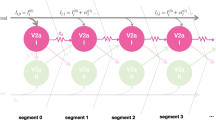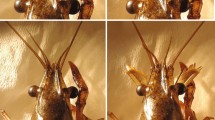Summary
The duration of the electric organ discharge (EOD) in Gymnotus carapo is brief and independent of fish size. Spinal mechanisms involved in electrocyte synchronization were explored by recording spontaneous action potentials of single fibers from the electromotor bulbospinal tract (EBST). Using the field potential of the medullary electromotor nucleus (MEN) as a temporal reference we calculated the orthodromic conduction velocity (CV) of these fibers (range: 10.7–91 m/s).
The CVs (in m/s) of fibers recorded at the same level of the spinal cord were significantly different in small and large fish; this difference disappeared when CV were expressed as percentage of body length/ms. Plotting these values against conduction distance (also in %) showed that low CV fibers predominate in the rostral cord while only fast fibers are found at distal levels. Moreover, antidromic stimulation of the distal cord was only effective on high CV fibers. The orthodromic CVs in the distal portion of the recorded fibers were calculated by collision experiments; no significant differences were found between proximal and distal portions.
The spatial distribution of CV values within the EBST is proposed to play the main role in synchronizing the electromotoneurons' activity along the spinal cord.
Similar content being viewed by others
Abbreviations
- EOD :
-
electric organ discharge
- EO :
-
electric organ
- EBST :
-
electromotor bulbospinal tract
- MEN :
-
medullary electromotor nucleus
- CV :
-
conduction velocity
- EMN :
-
electromotoneuron
References
Albe-Fessard D (1954) Nouvelle étude des latences spinales dans le dispositif de commande des organs éléctriques chez Electrophorus electricus L. Anais Acad Brasil Cienc 26:187–192
Albe-Fessard D, Martins-Ferreira H (1953) Rôle de la commande nerveuse dans la synchronisation du fonctionnement des éléments de l'organe éléctrique du gymnote Electrophorus electricus L. J Physiol (Paris) 45:533–546
Bennett MVL (1971) Electric organs. In: Hoar WS, Randall DJ (eds) Fish physiology. Academic Press, New York, pp 347–491
Bennett MVL, Giménez M, Nakajima Y, Pappas GD (1964) Spinal and medullary nuclei controlling electric organ in the eel, Electrophorus. Biol Bull 127:362
Bennett MVL, Grundfest H (1959) Electrophysiology of electric organ in Gymnotus carapo. J Gen Physiol 42:1067–1104
Bennett MVL, Pappas GD, Giménez M, Nakajima Y (1967a) Physiology and ultrastructure of electrotonic junctions. IV. Medullary electromotor nuclei in gymnotid fish. J Neurophysiol 30:236–300
Bennett MVL, Pappas GD, Aljure E, Nakajima Y (1967b) Physiology and ultrastructure of electrotonic junctions. II. Spinal and medullary electromotor nuclei in mormyrid fish. J Neurophysiol 30:180–208
Bullock TH (1982) Electroreception. Annu Rev Neurosci 5:121–170
Caputi A, Macadar O, Trujillo-Cenóz O (1989) Waveform generation of the electric organ discharge in Gymnotus carapo. III. Analysis of the fish body as an electric source. J Comp Physiol A 165:361–370
Denizot JP, Libouban S, Szabo T (1983) Anatomical study and HRP identification of electromotoneurons and motoneurons in the spinal cord of Gymnarchus niloticus. Exp Brain Res 53:99–108
Dickinson Gibbons J (1971) Linear rank tests for the location problem. In: Blackwell D, Solomon H (eds) Nonparametric statistical inference. McGraw-Hill, New York, pp 163–172
Dye JC, Meyer JH (1986) Central control of the electric organ discharge in weakly electric fish. In: Bullock TH, Heiligenberg W (eds) Electroreception. Wiley, New York, pp 71–102
Ellis DB, Szabo T (1980) Identification of different cell types in the command (pacemaker) nucleus of several gymnotiform species by retrograde transport of horseradish peroxidase. Neuroscience 5:1917–1929
Hagedorn M, Carr C (1985) Single electrocytes produce a sexually dimorphic signal in South American electric fish Hypopomus occidentalis (Gymnotiformes, Hypopomidae). J Comp Physiol A 156:511–523
Hess A, Young JZ (1949) Correlation of internodal length and fiber diameter in the central nervous system. Nature 164:490–491
Hopkins CD (1972) Sex differences in electric signal in an electric fish. Science 176:1035–1037
Hopkins CD (1980) Evolution of electric communication channels of mormyrids. Behav Ecol Sociobiol 7:1–13
Macadar O, Lorenzo D, Velluti JC (1989) Waveform generation of the electric organ discharge in Gymnotus carapo. II. Electrophysiological properties of single electrocytes. J Comp Physiol A 165:353–360
Meszler RM, Pappas GD, Bennett MVL (1974) Morphology of the electromotor system in the spinal cord of the electric eel Electrophorus electricus. J Neurocytol 3:251–261
Pappas GD, Bennett MVL (1966) Specialized junctions involved in electrical transmission between neurons. Ann NY Acad Sci 137:495–508
Szabo T (1961) Anatomophysiologie des centres nerveux de quelques organes éléctriques. In: Chagas C, Paes de Carvalho A (eds) Bioelectrogenesis. Elsevier, Amsterdam, pp 185–201
Trujillo-Cenóz O, Echagüe JA (1989) Waveform generation of electric organ discharge in Gymnotus carapo. I. Morphology and innervation of the electric organ. J Comp Physiol A 165:343–351
Trujillo-Cenóz O, Echagüe JA, Bertolotto C, Lorenzo D (1986) Some aspects of the structural organization of the spinal cord of Gymnotus carapo (Teleostei, Gymnotiformes) I. The electromotor neurons. J Ultrastruct Molec Struct Res 97:130–143
Author information
Authors and Affiliations
Rights and permissions
About this article
Cite this article
Lorenzo, D., Sierra, F., Silva, A. et al. Spinal mechanisms of electric organ discharge synchronization in Gymnotus carapo . J Comp Physiol A 167, 447–452 (1990). https://doi.org/10.1007/BF00192581
Accepted:
Issue Date:
DOI: https://doi.org/10.1007/BF00192581




